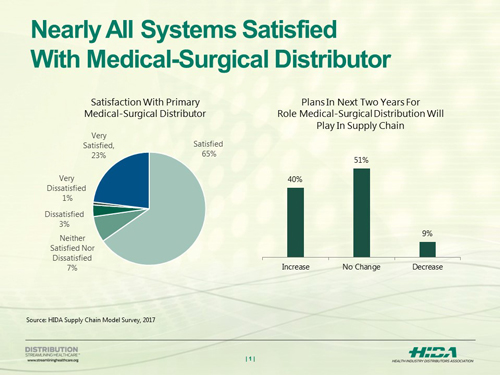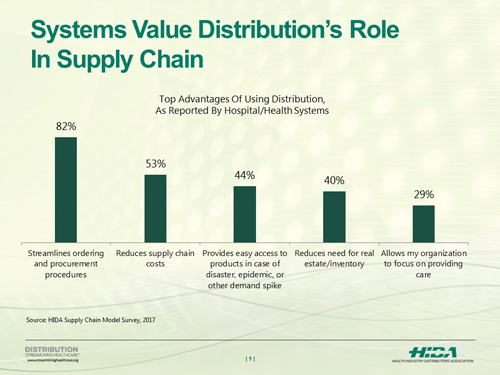By Jeff Girardi, HIDA
Almost 90 percent of IDN and hospital supply chain executives are satisfied or very satisfied with their distribution partner, according to a recent HIDA survey. Below are some key findings from the upcoming report.
Providers value distribution’s role in streamlining healthcare
A majority of hospital and health system supply chain executives think their prime vendor distributor partner adds value to the supply chain. Distributors’ ability to streamline ordering and procurement was the top benefit identified. “We value the availability of a large selection of items,” said one Chief Financial Officer from the Southwest. “We never know what new item we are going to need next.”
Fifty three percent of respondents identified supply chain cost reductions as the top advantage of using distribution. Some respondents noted that buying direct can increase total costs: most suppliers have specific order level or delivery requirements, or charge additionally for shipping/freight – which is not always reflected on product list prices. “Small utilization of some products still makes using medical-surgical distribution model work for us,” said one Vice President of Supply Chain in the South. “We avoid small orders with large shipping cost, i.e. cheaper to use local distributor for low volume items.”
Still, cost reduction was also the number one reason some organizations cited for purchasing items directly from manufacturers. Respondents identified various factors influencing this decision, such as seeking better leverage on price and contract terms.
Many executives plan to increase distribution’s involvement in supply chain
Respondents plan to rely on distributors for additional product volume in the coming years, according to comments from survey participants. Whether “funneling additional products through the distributor to reduce freight costs,” or shifting “more Physician Preference Items (PPI)” into distribution channels, approximately 40 percent plan to increase their distributor’s role in supply chain over the next two years.
Eighty eight percent of supply chain executives are currently satisfied or very satisfied with their primary distributor, and many are looking to deepen these business partnerships. One example involves a health system asking its distributor for help “maximizing our continued efforts to standardize products and relying on their expertise as we attempt transitioning to just in time inventory.”
In fact, just-in-time and low-unit-of-measure inventory models that carry more frequent product delivery schedules and expedited emergency shipments when needed remain common among providers. Forty percent of respondents value distribution’s role in reducing their need for dedicated real estate or inventory space – partly due to the prevalence of these models. In addition, since fewer than 10 percent of systems have plans to construct either new consolidated service centers (7 percent) or distribution centers (8 percent) in the next three years, most providers will still rely on a primary medical-surgical distributor to deliver products to their organizations.
Keep an eye out for this Horizon Report, released in the first quarter of the year and covering many different aspects of provider supply chain models.


